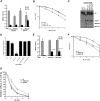MERIT40 controls BRCA1-Rap80 complex integrity and recruitment to DNA double-strand breaks
- PMID: 19261746
- PMCID: PMC2661612
- DOI: 10.1101/gad.1739609
MERIT40 controls BRCA1-Rap80 complex integrity and recruitment to DNA double-strand breaks
Abstract
Rap80 targets the breast cancer suppressor protein BRCA1 along with Abraxas and the BRCC36 deubiquitinating enzyme (DUB) to polyubiquitin structures at DNA double-strand breaks (DSBs). These DSB targeting events are essential for BRCA1-dependent DNA damage response-induced checkpoint and repair functions. Here, we identify MERIT40 (Mediator of Rap80 Interactions and Targeting 40 kD)/(C19orf62) as a Rap80-associated protein that is essential for BRCA1-Rap80 complex protein interactions, stability, and DSB targeting. Moreover, MERIT40 is required for Rap80-associated lysine(63)-ubiquitin DUB activity, a critical component of BRCA1-Rap80 G2 checkpoint and viability responses to ionizing radiation. Thus, MERIT40 represents a novel factor that links BRCA1-Rap80 complex integrity, DSB recognition, and ubiquitin chain hydrolytic activities to the DNA damage response. These findings provide new molecular insights into how BRCA1 associates with independently assembled core protein complexes to maintain genome integrity.
Figures







Similar articles
-
MERIT40 facilitates BRCA1 localization and DNA damage repair.Genes Dev. 2009 Mar 15;23(6):719-28. doi: 10.1101/gad.1770609. Epub 2009 Mar 4. Genes Dev. 2009. PMID: 19261748 Free PMC article.
-
RAP80 targets BRCA1 to specific ubiquitin structures at DNA damage sites.Science. 2007 May 25;316(5828):1198-202. doi: 10.1126/science.1139516. Science. 2007. PMID: 17525341 Free PMC article.
-
RNF4-dependent hybrid SUMO-ubiquitin chains are signals for RAP80 and thereby mediate the recruitment of BRCA1 to sites of DNA damage.Sci Signal. 2012 Dec 4;5(253):ra88. doi: 10.1126/scisignal.2003485. Sci Signal. 2012. PMID: 23211528 Free PMC article.
-
RAP80 and RNF8, key players in the recruitment of repair proteins to DNA damage sites.Cancer Lett. 2008 Nov 28;271(2):179-90. doi: 10.1016/j.canlet.2008.04.046. Epub 2008 Jun 11. Cancer Lett. 2008. PMID: 18550271 Free PMC article. Review.
-
RAP80, ubiquitin and SUMO in the DNA damage response.J Mol Med (Berl). 2017 Aug;95(8):799-807. doi: 10.1007/s00109-017-1561-1. Epub 2017 Jul 5. J Mol Med (Berl). 2017. PMID: 28681078 Free PMC article. Review.
Cited by
-
Ubiquitination by HUWE1 in tumorigenesis and beyond.J Biomed Sci. 2018 Sep 4;25(1):67. doi: 10.1186/s12929-018-0470-0. J Biomed Sci. 2018. PMID: 30176860 Free PMC article. Review.
-
ABRAXAS1 orchestrates BRCA1 activities to counter genome destabilizing repair pathways-lessons from breast cancer patients.Cell Death Dis. 2023 May 17;14(5):328. doi: 10.1038/s41419-023-05845-6. Cell Death Dis. 2023. PMID: 37198153 Free PMC article.
-
RAP80-directed tuning of BRCA1 homologous recombination function at ionizing radiation-induced nuclear foci.Genes Dev. 2011 Apr 1;25(7):685-700. doi: 10.1101/gad.2011011. Epub 2011 Mar 15. Genes Dev. 2011. PMID: 21406551 Free PMC article.
-
Deubiquitylating enzymes and DNA damage response pathways.Cell Biochem Biophys. 2013 Sep;67(1):25-43. doi: 10.1007/s12013-013-9635-3. Cell Biochem Biophys. 2013. PMID: 23712866 Free PMC article. Review.
-
RAP80 protein is important for genomic stability and is required for stabilizing BRCA1-A complex at DNA damage sites in vivo.J Biol Chem. 2012 Jun 29;287(27):22919-26. doi: 10.1074/jbc.M112.351007. Epub 2012 Apr 25. J Biol Chem. 2012. PMID: 22539352 Free PMC article.
References
-
- Bridge W.L., Vandenberg C.J., Franklin R.J., Hiom K. The BRIP1 helicase functions independently of BRCA1 in the Fanconi anemia pathway for DNA crosslink repair. Nat. Genet. 2005;37:953–957. - PubMed
-
- Celeste A., Fernandez-Capetillo O., Kruhlak M.J., Pilch D.R., Staudt D.W., Lee A., Bonner R.F., Bonner W.M., Nussenzweig A. Histone H2AX phosphorylation is dispensable for the initial recognition of DNA breaks. Nat. Cell Biol. 2003;5:675–679. - PubMed
Publication types
MeSH terms
Substances
Grants and funding
LinkOut - more resources
Full Text Sources
Other Literature Sources
Molecular Biology Databases
Miscellaneous
